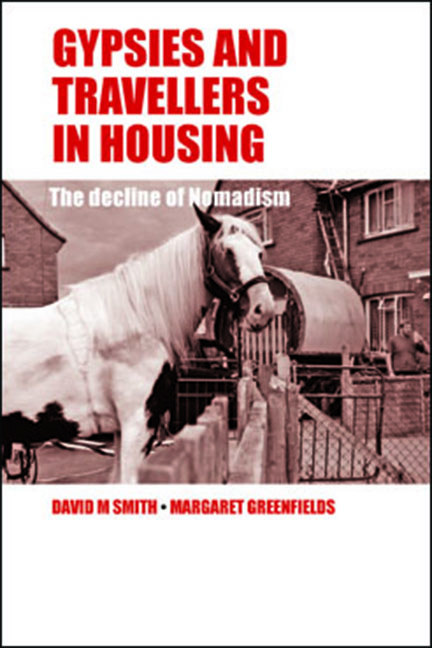Book contents
- Frontmatter
- Contents
- List of tables
- Acknowledgements
- Foreword
- one Introduction
- two Space, surveillance and modernity
- three Gypsies, nomads and urbanisation: a social history
- four The research sites and population sample
- five Routes into housing
- six Housing transitions
- seven Gypsies, Travellers and gorjers: conflict and cooperation
- eight Recreating community
- nine Young people in housing: aspirations, social relations and identity
- ten Conclusion
- Appendix A Methodologies
- Appendix B Glossary of words and terms
- References
- Index
five - Routes into housing
Published online by Cambridge University Press: 03 February 2022
- Frontmatter
- Contents
- List of tables
- Acknowledgements
- Foreword
- one Introduction
- two Space, surveillance and modernity
- three Gypsies, nomads and urbanisation: a social history
- four The research sites and population sample
- five Routes into housing
- six Housing transitions
- seven Gypsies, Travellers and gorjers: conflict and cooperation
- eight Recreating community
- nine Young people in housing: aspirations, social relations and identity
- ten Conclusion
- Appendix A Methodologies
- Appendix B Glossary of words and terms
- References
- Index
Summary
In all of the research locales outlined in the previous chapter, significant Gypsy and Traveller populations are resident in conventional housing as a consequence of the broader legislative, social and historical forces previously discussed as well as resulting from individual preferences and circumstances. In recent decades, the housing ‘careers’ and residential characteristics of minority groups have received extensive attention (Sarre et al, 1989; Somerville and Steele, 2002; Robinson and Reeve, 2006), with research consistently showing that despite significant differences between BME groups they tend as a category to be disadvantaged in relation to housing; 26 per cent of BME households reside in social housing compared to 18 per cent of all households in England and Wales. Evidence also indicates that these households experience higher levels of over-crowding and are more likely to be concentrated in deprived areas (Shelter, 2010b). Since 1997 levels of homelessness among BME households have risen at over twice the rate of the general population (Shelter, 2004). This trend may well accelerate in coming years as a result of their concentration in urban centres, particularly London due to its high concentration of BME groups. More recently concern has been expressed that a combination of housing benefit caps, a severe shortage of affordable housing and high rents in the private rental sector will result in a rise in homelessness and a significant relocation of low income groups beyond the boundaries of the capital to areas where rents are lower (Radical Islington, 2012) in essence creating ghettos for the poor similar to the ‘banlieues’ of Paris (Silverstein and Tetreault, 2006). Families with more than three children will be particularly affected as the number of London neighbourhoods that are not ‘largely unaffordable’ for housing benefit claimants will be halved (from 75 to 36 per cent) by 2016 as a result of reforms to the Local Housing Allowance (LHA) (Shelter, 2010a). This process of spatial restructuring (as we saw in Chapter Two) is global in nature: as nation states have become more spatially polarised between a ‘network of globalized metropolitan centres’ and ‘non metropolitan localities and peripheries’ so the poor, economically inactive and those minorities who are unable, or unwilling, to participate as global actors and consumers are subject to new forms of spatial zoning and control (Bancroft, 2005, p 5).
- Type
- Chapter
- Information
- Gypsies and Travellers in HousingThe Decline of Nomadism, pp. 89 - 108Publisher: Bristol University PressPrint publication year: 2013



